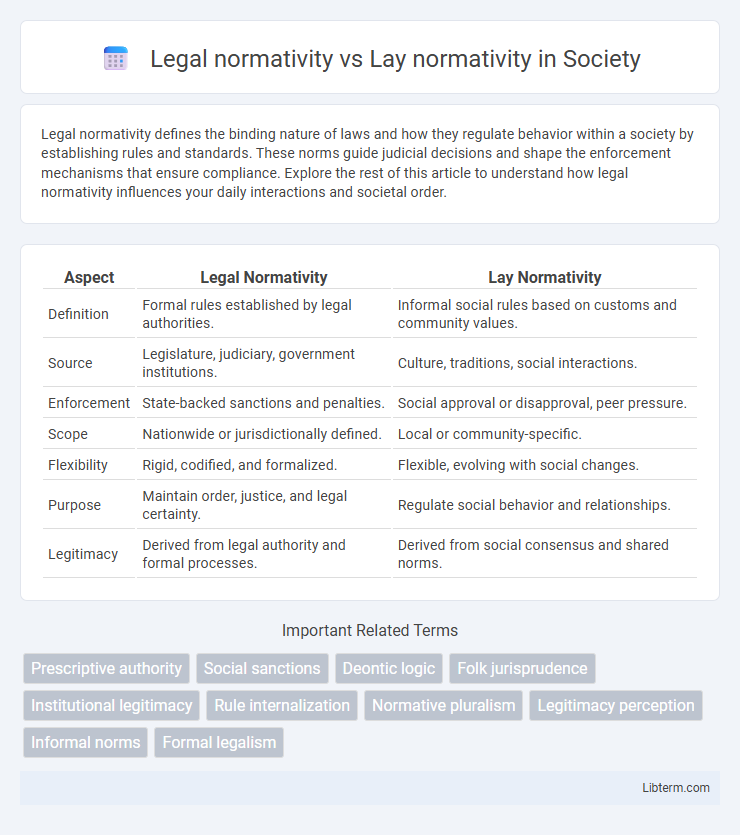Legal normativity defines the binding nature of laws and how they regulate behavior within a society by establishing rules and standards. These norms guide judicial decisions and shape the enforcement mechanisms that ensure compliance. Explore the rest of this article to understand how legal normativity influences your daily interactions and societal order.
Table of Comparison
| Aspect | Legal Normativity | Lay Normativity |
|---|---|---|
| Definition | Formal rules established by legal authorities. | Informal social rules based on customs and community values. |
| Source | Legislature, judiciary, government institutions. | Culture, traditions, social interactions. |
| Enforcement | State-backed sanctions and penalties. | Social approval or disapproval, peer pressure. |
| Scope | Nationwide or jurisdictionally defined. | Local or community-specific. |
| Flexibility | Rigid, codified, and formalized. | Flexible, evolving with social changes. |
| Purpose | Maintain order, justice, and legal certainty. | Regulate social behavior and relationships. |
| Legitimacy | Derived from legal authority and formal processes. | Derived from social consensus and shared norms. |
Defining Legal Normativity
Legal normativity encompasses the system of rules and principles established and enforced by authoritative institutions, ensuring compliance through sanctions and formal mechanisms. It defines obligations, rights, and duties within a structured legal framework, distinct from lay normativity, which emerges from community practices and social expectations without formal enforcement. Understanding legal normativity requires analyzing characteristics such as normative force, institutional endorsement, and the role of legal reasoning in guiding behavior and resolving conflicts.
Understanding Lay Normativity
Lay normativity encompasses the informal rules and shared expectations that communities develop independently from formal legal systems, guiding everyday social interactions and behaviors. Unlike legal normativity, which relies on codified laws enforced by institutions, lay normativity operates through social acceptance, moral judgments, and cultural practices within groups. Understanding lay normativity requires examining how these unwritten norms influence compliance and cohesion, shaping social order without formal legislation.
Philosophical Foundations of Legal Normativity
Legal normativity emerges from institutionalized rules enforced by recognized authorities, grounded in philosophical theories such as legal positivism and natural law, which assert the binding force of laws through sovereignty and moral principles respectively. Lay normativity, by contrast, arises from social conventions and communal practices without formal codification or authoritative enforcement, reflecting collective moral understandings within societies. The philosophical foundations of legal normativity emphasize the legitimacy and coercive power of law as distinct from the descriptive and prescriptive nature of lay norms embedded in everyday social interactions.
Sources of Lay Normativity in Society
Sources of lay normativity in society primarily arise from cultural traditions, social practices, and communal values that guide everyday behavior outside formal legal systems. These norms often emerge through family teachings, religious beliefs, and peer interactions, creating a framework for acceptable conduct within specific social groups. Unlike legal normativity rooted in codified laws and official institutions, lay normativity is grounded in collective social understanding and informal enforcement mechanisms.
Authority and Legitimacy in Legal and Lay Norms
Legal normativity derives its authority from formal institutions such as legislatures and courts, establishing legitimacy through codified laws and enforcement mechanisms. Lay normativity gains authority from social consensus and shared cultural values, with legitimacy rooted in community acceptance and moral endorsement. The interplay between these forms of normativity highlights how legal systems rely on societal legitimacy, while lay norms influence and sometimes challenge formal legal authority.
The Role of Interpretation in Legal and Lay Norms
Legal normativity requires interpretation grounded in statutory language, judicial precedent, and institutional authority to ensure consistency and enforceability within formal legal systems. Lay normativity relies on social context, cultural values, and community consensus, where interpretation is more flexible and adaptive to everyday interactions. The role of interpretation in both domains is crucial for translating abstract rules into practical guidance, shaping behavior according to either codified laws or communal expectations.
Case Studies: Legal vs Lay Norms in Practice
Case studies examining legal normativity versus lay normativity highlight the contrasting sources and enforcement mechanisms of norms within societies. Legal normativity relies on codified laws enforced by judicial systems, exemplified by court rulings that establish binding precedents, while lay normativity emerges from social customs and informal agreements upheld through community consensus, as seen in indigenous conflict resolution practices. These case studies demonstrate how legal norms provide structured predictability, whereas lay norms offer flexible, context-sensitive solutions, revealing the dynamic interaction between formal law and social practice in governance.
Conflicts Between Legal and Lay Normativity
Conflicts between legal normativity and lay normativity arise when formal legal rules clash with community-based social norms, often creating tensions in enforcement and compliance. Legal normativity, grounded in codified laws and institutional authority, may be perceived as rigid or disconnected from local customs and moral beliefs upheld by laypeople. Resolving these conflicts requires balancing statutory obligations with cultural legitimacy to enhance legitimacy and social cohesion in pluralistic societies.
Social Consequences of Normative Divergence
Legal normativity establishes formal rules enforced by state institutions, while lay normativity arises from social customs and everyday practices within communities. Divergence between these normative systems can lead to social conflicts, reduced compliance, and challenges in governance as individuals prioritize informal norms over official laws. Understanding how normative divergence impacts social cohesion and legal legitimacy is crucial for effective policy-making and conflict resolution.
Bridging the Gap: Harmonizing Legal and Lay Normativity
Bridging the gap between legal normativity and lay normativity requires understanding the distinct sources and functions of each system, where legal norms derive from formal legislative and judicial processes while lay norms emerge from social practices and cultural values. Effective harmonization involves fostering dialogue between legal institutions and communities to ensure laws resonate with everyday moral intuitions and social expectations. Enhancing mutual recognition and adaptability promotes compliance, legitimacy, and the co-creation of norms that reflect both institutional authority and lived experiences.
Legal normativity Infographic

 libterm.com
libterm.com